Key Takeaways
- Students working on a highly collaborative project used social networking technology for community building activities as well as basic project-related communication.
- Requiring students to work on cross-program projects gives them real-world experience working in diverse, geographically dispersed groups.
- An application used at Appalachian State University integrates popular social networking tools, text messaging, and e-mail while maintaining student privacy and streamlining group communications.
The Department of Leadership and Educational Studies (LES) at Appalachian State University in Boone, North Carolina, offers a comprehensive set of post-baccalaureate degree programs to its students, many of whom already work in the education field. To serve such busy, full-time professionals, most classes meet on satellite campuses scattered across central and western North Carolina, or online through extension and distance learning programs. Although such a structure makes learning convenient and affordable, it also disperses students geographically, sometimes reinforcing learning silos based on degree areas rather than encouraging an integrated community. To counteract these effects, the department has instituted several innovative strategies to promote community building and collaborative learning.
The Context for Instituting New Strategies
Several existing conditions influenced our planning and implementation. Goals included:
- Creating cross-program activities to break down silos
- Finding communication tools to supplement our 3D virtual world for teaching and learning
- Accommodating students during a summer session when they had planned absences
- Integrating the communication tools in a way that best served students and faculty
The Need for Cross-Program Activities
To create comfortable and familiar social settings among classmates over the approximately six semesters of their programs, LES uses a cohort model. While cohorts reinforce a feeling of community within study areas (in this case, school administration, higher education, library science, or instructional technology), cohorts are isolated from the main campus, each other, and (most importantly) other program disciplines. This situation is the exact opposite of the integrated community that we want to encourage in our K–12 and higher education settings, and it also conflicts with our own philosophies about teaching.
To alleviate this problem, we developed cross-program collaborative initiatives among three of our four program areas: school administration, library science, and instructional technology. The idea was that school leaders emerging from these particular programs must have experience in how to tackle complex issues in collaboration with diverse roles. We began by dividing students into groups that had members from each of the various degree programs. Each group had specific assignments, such as developing a vision for the 21st-century school, and group members could meet online to discuss the issue from the perspective of their future roles in K–12 schools. These discussions encouraged collaboration because each group member was responsible for contributing to the vision from the perspective of the field he or she represented.
The theory behind our cross-program initiative is based on the Conceptual Framework of the Reich College of Education. Founded on the tenets of social constructivism and communities of practice, this framework calls for the type of social interaction and learning that our cross-program project promoted. Since as much as 100 miles separates our students, they used online collaboration tools in ways that require social interaction while working on real-world, school-based issues.
Online Communication Systems
Guided by the college's Conceptual Framework, faculty members in our department have developed a 3D virtual world for teaching and learning, the AET Zone. Developed over the last nine years, the Zone is built on the Active Worlds platform and supports the social constructivist learning experiences we provide students in our courses and programs.1 The Zone is a place where students from different program areas can access resources and interact with students and faculty.2 For instance, it has a commons area (shown in Figure 1), much like a plaza or quad at a typical campus. Students can meet in class spaces or informal chat areas; they can also access online library services. The AET Zone has won awards such as the 2006 Campus Technology Innovators Award for Virtual and Immersive Learning and, most recently, the North Carolina Distance Learning Association 2010 Award for Best Practices in Distance Learning.
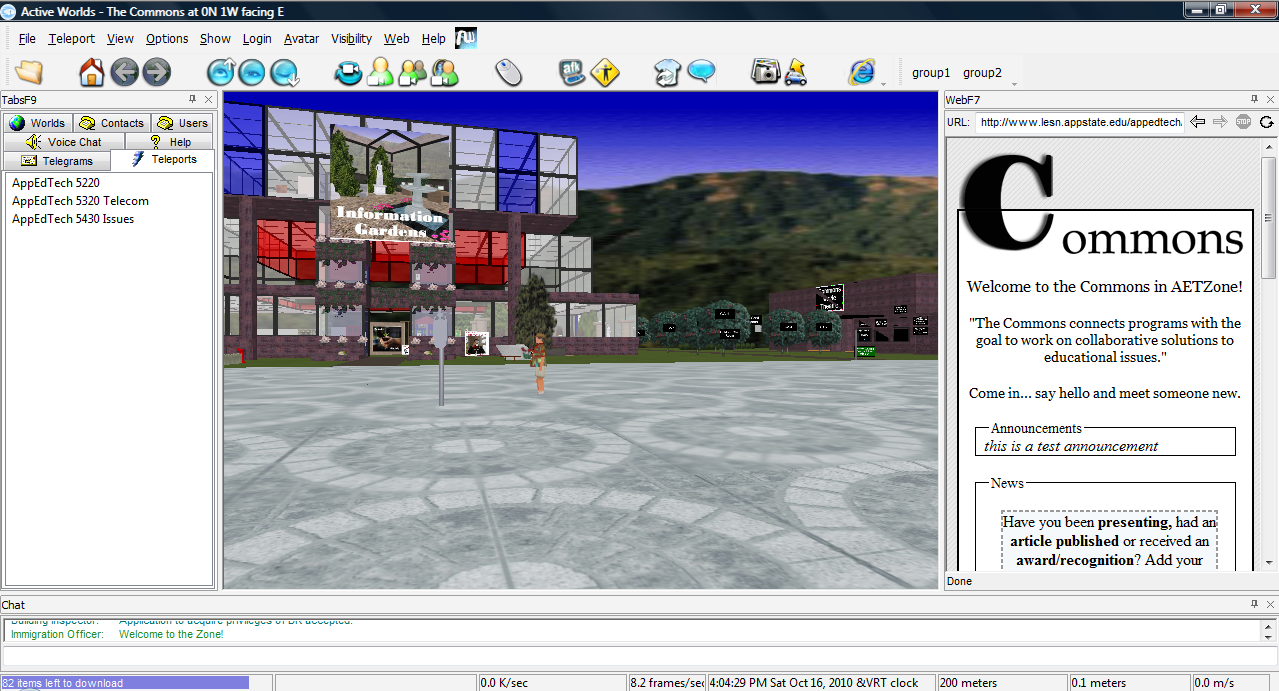
Figure 1. Commons Area of the AET Zone Virtual World
As useful as the Zone has been in providing rich online collaborative opportunities, we wanted to supplement it with more widely used and accessible tools. Collaborative virtual environments like the Zone require computer access, for instance, so students tend to use them primarily in the evenings, around the time of most online course meetings. To encourage more frequent daily interaction and social collaboration, we turned to social networking tools already popular with our students, such as Twitter and Facebook. These technologies are pervasive in daily life and accessible on small mobile devices, like cell phones. Our cross-program activity provided an opportunity to test the always-available nature of social networking tools for group communication, as a supplement to class meeting activities in the Zone.
We wondered whether students would use these tools merely to work together on assignments, or to socialize and build a community. We also wanted to investigate the extent to which students would use these tools in addition to online systems like the Zone, and whether they perceived the pervasiveness of social networking tools as beneficial.
Designing a Summer Cross-Program Activity
During summer 2010, four faculty members in our department (representing school administration, library science, and instructional technology) planned and carried out a cross-program activity within six course sections. We created groups of students responsible for collaborating to develop a vision of a 21st-century educated person. A total of 127 students participated, 111 women (87 percent) and 16 men (13 percent). Each of the 27 groups had three to five students, with at least two program areas represented in each group. The groups had two weeks to complete the project. To begin this activity, each group considered the following questions:
- What's happening now in schools, businesses, jobs, populations, and demographics?
- How are these changing? What resources will you need to be able to create this vision? How will you work as a team?
- What added value does each member from the respective program areas bring to the team?
- How do professional teams operate successfully to accomplish tasks?
A major component of this project was to understand each group member's role and the contribution each role made to collaborative leadership within a pre-K through higher education setting. Students completed blogs and postings in forums to report on their group's progress. This requirement provided transparent accountability for participation because all groups saw these postings. At the end of the process, students reflected on the experience and analyzed their individual contribution to both the product and the process relevant to their field. In school administration classes, for example, skills necessary to lead diverse groups and the process of group dynamics became major focal points prior to and during the project. Other program areas focused on aspects relevant to leadership in their field while exploring group dynamics among diverse roles.
Instructors had the academic freedom to hold individual students accountable through whatever means they determined appropriate. Overall, all student groups posted their final products online to share with the larger group.
Advantages of Social Networking
Several aspects of the cross-program project made it different from our usual courses and affected our choice of telecommunications tools.
- Experience with communication tools. Many, though not all, groups had used the AET Zone prior to the semester to communicate with peers in the immersive space. Therefore, not all the students had experience in a common platform for online communications.
- Different class modes. Some cohorts participating in the project were completely online, others met in a blended mode, and one section met face-to-face during the summer semester.
- Summer schedules. Most students were in-service teachers and school administrators. Many in the online and blended sections had plans to be away at professional development activities, or even family vacations, during a few days of the project.
Given these characteristics, the Zone could not be the only communication and meeting platform for our cross-program groups. For one, those without experience using the Zone would likely not be proficient soon enough to meet the deadlines of a short project. More importantly, however, we wanted to address the needs of those who were planning to be out of town: They would need a system for communication and sharing ideas that was accessible anywhere, be it on the road or in a rented beach house without an Internet connection.
Social networking tools, such as Facebook and Twitter, would be ideal; both allow students to access messages from their groups though mobile phones. Moreover, social networking tools would maintain a sense of community and support the social constructivist experiences we aim to provide. However, there were several drawbacks to using Facebook and Twitter. For example, some students did not have Facebook or Twitter accounts, and others were reluctant to create an account because of privacy concerns. Still others who had personal accounts for one or both of these tools did not necessarily want to "friend" someone whom they knew only from the project. Therefore, we looked for a tool that would allow those without a Facebook or Twitter account to engage with others via e-mail or text messaging. We also wanted a tool that would work with students who would rather receive and send messages to their group via their Facebook wall or Twitter tweets.
ConnectYard to Integrate Communication
We had talked to representatives from ConnectYard about testing their application after seeing it at the 2010 EDUCAUSE Learning Initiative Annual Meeting in Austin, Texas. Further talks and a hands-on demo convinced us that this tool might serve our cross-program need. ConnectYard integrates Facebook, Twitter, text messaging, and e-mail into a single communication thread. The ConnectYard widget (shown in Figure 2) is embedded within a web page, and it displays a list of messages within a group. Students can choose to send and receive messages via Facebook, Twitter, text messaging, e-mail, and/or directly through the web-embedded widget. Students do not need to friend or follow others in a group when interacting though one of the popular social networking sites. They also do not need to share cell phone numbers to text message directly. ConnectYard takes care of interfacing with these networks, thereby alleviating many of the privacy concerns students might have about communicating with strangers in this cross-program activity.
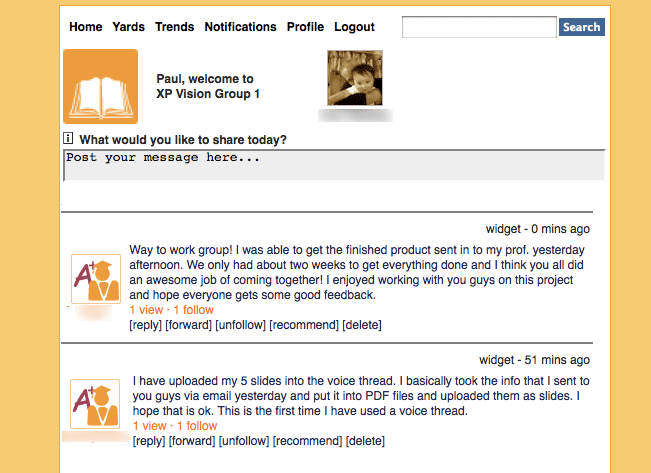
Figure 2. ConnectYard Widget
Prior to beginning the project, we set up 27 groups ("yards" in ConnectYard), one for each project group. A common web page that we created listed all the project groups, members, and a link to each group's ConnectYard widget page. On their first visit to the widget page, students either signed up for a ConnectYard account or signed into ConnectYard using their Facebook or Twitter log-in details. Once signed in, they could specify preferences for sending and receiving messages.
Initially, we asked all students to send out a welcome message providing a brief self-introduction to their group via ConnectYard, so others would know a little about each member of their group. From then on, we instructed students to communicate about the project using any tool that all members of the group agreed on. We encouraged them to start their conversation using ConnectYard because faculty members were also signed up to receive messages from all groups, and could answer questions during the initial stages of the two-week project.
Assessing Cross-Program Communication Tools
During the evaluation of this project, we were interested not only in project-specific communications but also the extent to which students would use social networking tools to build and foster community. Influenced by Barbara Frey and Lorna Kearns's presentation3 on the use of social networking for back-channel communications at the 2009 ELI Annual Meeting, we too chose to look into our students' use of these tools for socialization and emotional support, in addition to project-specific communications.
To assess the use of ConnectYard, communication, and social networking tools in the cross-program project, we developed a survey and also had students reflect on their experiences using blogs, discussions in synchronous-audio class meetings, and through reflection papers. The Institutional Review Board at the university approved the use of these assessment tools. A link to the survey went to all students at the end of the summer semester, and 37 students responded.
Survey Results
The survey explored the students' use of ConnectYard during this project and also measured whether students believed that these tools contributed to learning. Table 1 summarizes how often students used ConnectYard for particular tasks, and Table 2 shows the underlying reasons for this use.
Table 1. Use of ConnectYard in the Cross-Program Project
Tasks | Never | Rarely | Sometimes | Often | Extensively |
| Collaborate on assignments | 2.7% | 5.4% | 27.0% | 43.2% | 21.6% |
| Clarify assignment requirements | 13.5% | 5.4% | 27.0% | 45.9% | 8.1% |
| Seek or provide technical help with technology tools | 37.8% | 24.3% | 16.2% | 16.2% | 5.4% |
| Socialize with others | 37.8% | 21.6% | 16.2% | 18.9% | 5.4% |
| Seek or provide emotional support | 48.6% | 13.5% | 21.6% | 13.5% | 2.7% |
Table 2. Underlying Reasons for Using ConnectYard
| Tasks | More Faculty-Expected | Mix of Both | More Self-Directed | Didn't Use for This |
| Collaborate on assignments | 45.9% | 45.9% | 5.4% | 2.7% |
| Clarify assignment requirements | 16.2% | 45.9% | 27.0% | 10.8% |
| Seek or provide help with technology tools | 0.0% | 43.2% | 21.6% | 35.1% |
| Socialize with others | 2.7% | 29.7% | 21.6% | 45.9% |
| Seek or provide emotional support | 2.7% | 16.2% | 32.4% | 48.6% |
More than half of participants reported using the tool for technical help, socializing, and emotional support — all aspects of community building, yet not directly related to the project assignment. Although most responded that the underlying reason for using these tools was faculty expectation, the usage for community building was more self-directed and outside the scope of the project's academic requirements, as Figure 3 shows.
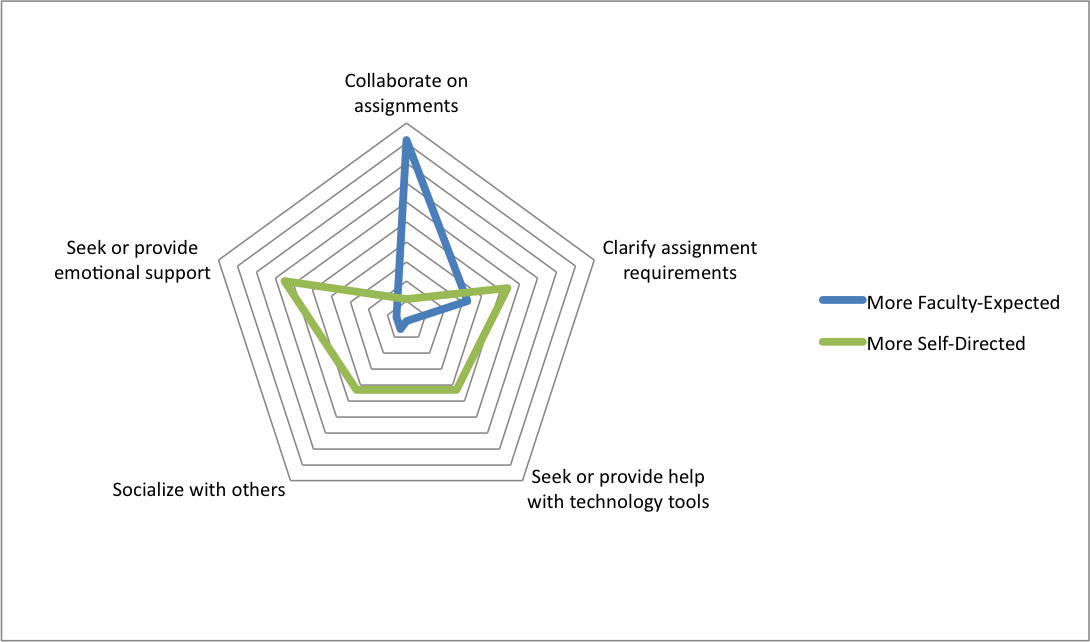
Figure 3. More Self-Directed Community Building Communication
Table 3 shows that most students found social networking tools to be somewhat or very valuable not only for collaborating on assignments and clarifying requirements but also for seeking and providing help with technology tools. In the other two areas — socializing with others, and seeking and providing emotional support — students who found these tools somewhat or very valuable outnumbered those who found no value in them.
Table 3. Perceived Value of Social Networking as a Project Communication Tool
Tasks | No Value | Slightly Valuable | Somewhat Valuable | Very Valuable | Didn't Use for This |
| Collaborate on assignments | 8.1% | 21.6% | 29.7% | 40.5% | 0.0% |
| Clarify assignment requirements | 8.1% | 13.5% | 32.4% | 40.5% | 5.4% |
| Seek or provide help with technology tools | 10.8% | 16.2% | 27.0% | 29.7% | 16.2% |
| Socialize with others | 18.9% | 10.8% | 18.9% | 29.7% | 21.6% |
| Seek or provide emotional support | 24.3% | 10.8% | 24.3% | 16.2% | 24.3% |
Participants believed that using social networking tools to communicate about the project contributed to their learning. The majority (60 percent) of those who participated in the study agreed with this statement. Figure 4 depicts a word cloud of open-ended responses to a follow-up question asking how social networking tools contributed to learning. Note, however, that these results are self-reported perceptions of students completing the survey and should be interpreted as such. That is, we are not asserting that social networking tools increased learning, yet this could be the subject of further research.
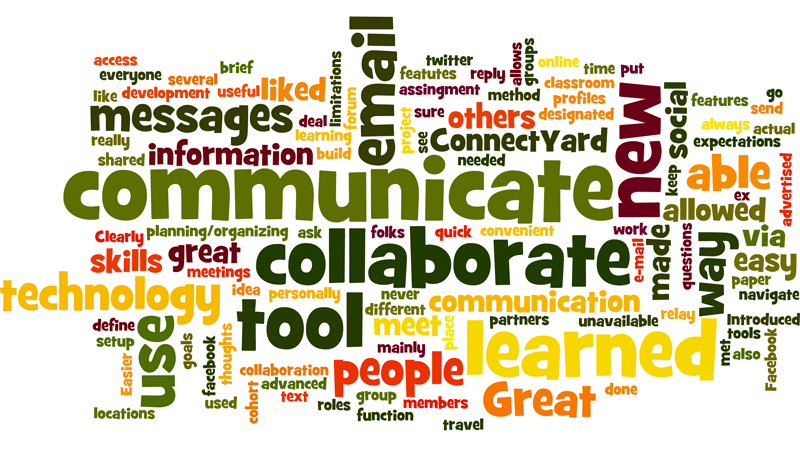
Figure 4. Word Cloud of Student Responses to "How Did Social Networking Tools Contribute to Learning?"
With many students traveling during the summer, it was important to let them choose the most convenient means of sending and receiving messages. Looking at specific tools that students chose to send and receive messages, Tables 4 and 5 show that most used e-mail, yet nearly half (46 percent) used Twitter, Facebook, or text messaging throughout the activity. In fact, text messaging was much more popular for sending and receiving group messages than Twitter and Facebook combined, and more popular even than Twitter and Facebook clients on cell phones. With the increase in smart phone adoption, however, these figures might change.
Table 4. Students' Choice of Ways to Receive Project Messages within ConnectYard
Application for Receiving Messages | Not at All | From Time to Time | Throughout the Activity |
| 8.1% | 5.4% | 86.5% | |
| 81.1% | 10.8% | 8.1% | |
| 86.5% | 2.7% | 10.8% | |
| Text messaging | 64.9% | 8.1% | 27.0% |
Table 5. Students' Choice of Ways to Send Project Messages within ConnectYard
Application for Sending Message | Never | Rarely | Sometimes | Often | Extensively |
| 16.2% | 5.4% | 13.5% | 21.6% | 43.2% | |
| 86.5% | 10.8% | 2.7% | 0.0% | 0.0% | |
| 86.5% | 2.7% | 2.7% | 2.7% | 5.4% | |
| Text messaging | 67.6% | 8.1% | 2.7% | 10.8% | 10.8% |
| Group web page (widget) | 43.2% | 5.4% | 16.2% | 16.2% | 18.9% |
Last, we wanted to know what other communication tools students employed in this project (outside of ConnectYard) and to what extent they used social networking tools overall. Figure 5 shows a graph of the additional communication tools students reported using, which included 3D virtual worlds (like the Zone) and audio conferencing. Participants reported that overall, they used social networking tools for more than 50 percent of project communication.
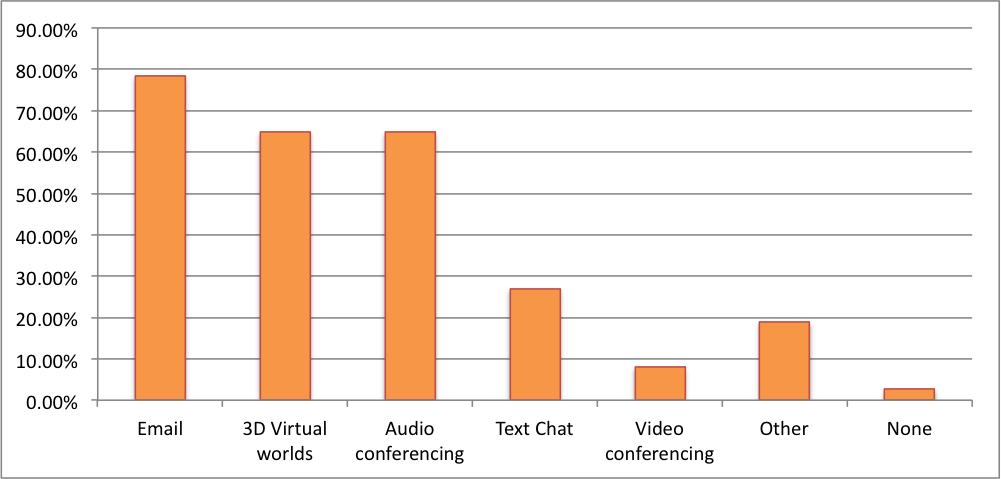
Figure 5. Additional Communication Tools Used by Students in the Cross-Program Project
Student Comments
Many themes that came from student reflections and comments revolved around the convenience of ConnectYard's integration of social networking tools. In particular, many students appreciated the ability to stay connected with their group using mobile devices:
"More convenient to use than e-mail for brief communication."
"Great tool to use when planning/organizing with groups, easy to navigate, could have messages sent via text (for example, when traveling)."
"I really liked the features it allowed, quick access to messages via Facebook, text, and e-mail."
"Made it super easy to collaborate on the go."
In addition, other comments focused on the ability to organize thoughts and keep up with the flow of information within the program group:
"ConnectYard was a way to put our thoughts on 'paper' and have others build from that idea."
"It made me more able to communicate with several people at the same time. We were able to relay information to all the members of our group at once. It was a great method for communication."
"Allowed our group to clearly define roles, goals, and expectations before and during the assignment."
Finally, several students commented on the fact that it was a novel tool for them, and they appreciated being introduced to new ways of communicating:
"I learned a new way to 'meet' with folks online."
"Introduced me to a new tool."
"I always like learning new tools."
Lessons Learned
As we consider adopting social networking tools in future cross-program projects and in regular online and blended courses, we must evaluate both the benefits and drawbacks of their use. In this cross-program activity, we identified the following benefits:
- Community development. In keeping with our philosophy of social constructivism and building communities of practice within online and blended cohorts, communication tools that foster social interaction and collaboration are paramount. We have experienced great success with the Zone and were interested in exploring the use of social networking tools to extend the sense of community outside the virtual environment. Survey results indicate that students do use social networking tools for community building.
- Flexibility. In the open-ended responses and feedback, students reported that social networking tools can be more convenient than e-mail for collaborating in project groups. One theme that arose many times was the value of these tools for those who travel often and need to communicate via mobile devices. As our students are primarily in-service teachers and administrators, the ability to stay connected throughout the day and on the go is becoming an important aspect of their degree programs.
- Shallow learning curve. By using tools that students already use (e-mail, Facebook, and Twitter), the project let students start communicating immediately, with no time lost to learning new tools.
- Alleviating privacy concerns. The use of ConnectYard to integrate Facebook, Twitter, text messaging, and e-mail allowed students to maintain privacy. It also let them choose how to send and receive group messages.
There were many benefits to using ConnectYard and social networking tools, and students were overwhelmingly positive in their comments on its use. We did, however, uncover some small problems to sort out before attempting another cross-program activity. Some problems arose from our planning and the limited time to complete the project during the summer. Others arose from technical details and preferences in ConnectYard.
One problem was the character limits in some of the communication systems. For example, Twitter tweets are limited to 140 characters; text messages, 160 characters. Since students chose how to send messages, many did not consider that Twitter or text-messaging services would truncate long messages sent from e-mail. Moreover, project documents sent as attachments were not viewable in some of these applications. During our project, ConnectYard was working on a feature to break up long messages into separate tweets and text messages. We could investigate that feature to see if it alleviates the problems reported by our students. Also, we will need to provide more guidance to students in advance about writing concise messages and storing documents in online services where group members can download them, instead of attaching these to ConnectYard messages.
This project is part of a continuing effort among the faculty in our department to break down the silos of learning created by the structure of off-campus programs. The use of social networking tools allows our students to engage in a level of collaboration that would be awkward, if not impossible, without a means to communicate effectively. This particular project focused on the tools of collaboration. We will continue to explore options for developing stronger and more long-term collaborative projects that will build communities of practice among students for the duration of their graduate programs rather than over the course of one short semester.
- Stephen Bronack, Richard Riedl, John Tashner, and Melanie Greene, "Learning in the Zone: A Social Constructivist Framework for Distance Education in a 3D Virtual World," in Carolyn M. Crawford et al., eds., Proceedings of Society for Information Technology & Teacher Education International Conference 2006 (Chesapeake, VA: AACE), pp. 268–275.
- Robert L. Sanders and Shanna J. Melton, "The AETZone Experience: A Qualitative Analysis of the Use of Presence Pedagogy in a 3D Immersive Learning Environment," MERLOT Journal of Online Learning and Teaching, vol. 6, no. 1 (March 2010), pp. 62–70.
- Barbara A. Frey and Lorna R. Kearns, "Back-Channel Communication: Web 2.0 Technologies for Social Learning," presentation at the EDUCAUSE Learning Initiative Annual Meeting, held in Orlando, Florida, January 20–22, 2009.
© 2010 Paul Wallace and Barbara Howard. The text of this article is licensed under the Creative Commons Attribution-Noncommercial-No Derivative Works 3.0 license.
